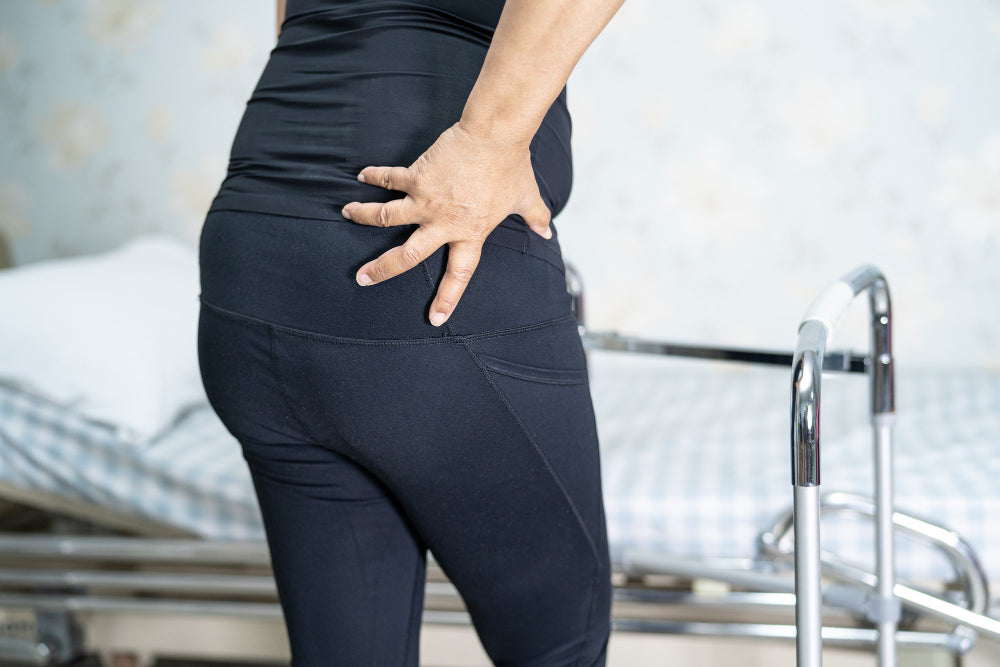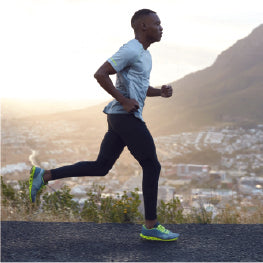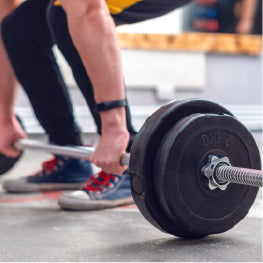What Is a Hip Impingement? Injury Overview
If you are having hip stiffness or pain, then you may be dealing with a hip impingement. But what is a hip impingement?
Here's what you need to know.

What Is a Hip Impingement? Injury Overview
If you are having hip stiffness or pain, then you may be dealing with a hip impingement. But what is a hip
impingement?
Here's what you need to know.
Related Articles
- Hip Impingement: Injury Overview
The Best Hip Impingement Treatments - The Best Hip Impingement Exercises
- The Best Hip Impingement Stretches
A hip impingement, also known as a femoroacetabular impingement (FAI) or acetabular rim syndrome, is a condition that limits the hip's range of motion. It affects 10% to 15% of people.
FAI is most common in people assigned male at birth and adults between the ages of 20 and 40. Without treatment, the condition can cause excessive friction and wear and tear on the hip joint. Over time, hip impingements may lead to early osteoarthritis.
Identifying the symptoms early can greatly reduce the risk of complications. That's why we are bringing you this guide to "What is a hip impingement?" Read on to learn about this condition's causes, symptoms, and treatments.
Hip Impingement vs. Labral Tear
Hip impingements and labral tears affect the hip joint, and they can be linked. The difference is that these conditions affect distinct parts of the hip joint, with impingements compromising the femur and acetabulum and labral tears impacting the labrum.
As with hip impingements, not getting treatment for a labral tear may increase the risk of osteoarthritis.
Hip Impingement vs. Labral Tear Causes
Experts are not 100% sure what causes hip impingements. Genetics likely plays a role. Many people who develop this syndrome have an extra bone or deformity in the hip that prevents the femur from working with the acetabulum properly.
Labral tears are injuries that can be obtained from sports or trauma. Like hip impingements, they can also happen due to structural abnormality. More commonly, labral tears are overuse injuries that happen due to the repetitive motion of running or similar activities.
Hip impingements are also a common cause of labral tears in men. In women, hip dysplasias are more likely to be the underlying cause.
Hip Impingement vs. Labral Tear Symptoms
Hip impingements and labral tears cause hip and groin pain, limited range of motion, and hip stiffness. Unique to labral tears is a clicking or popping sound when the hip joint locks.
Symptoms characteristic of hip impingements include the inability to flex the hip beyond a right angle, hip instability, limping, balance loss, trouble taking the stairs, and having legs of unequal lengths.
Hip Impingement vs. Labral Tear Diagnosis
Doctors use the same procedures to diagnose hip impingements and labral tears: imaging scans (e.g., MRIs and CT scans) or the hip impingement test. Diagnosing one hip joint condition often indicates the other.
Anatomy of the Hip Joint
The hip joint connects the trunk to the legs via the hip. The purpose of this joint is to support your body weight, allow you to move and rotate your legs, and absorb shock from traveling to the upper body.
This joint consists of two bones, two types of cartilage, and five ligaments.
Hip Joint Bones
The hip joint is made up of the pelvic bone and the femur, also known as the thighbone. The pelvis consists of three smaller bones: the ilium, ischium, and pubis.
Another term that's important to this topic is the acetabulum. The acetabulum is not technically a bone. It is a socket formed by the fusion of the ilium, ischium, and pubis- the small bones that make up the pelvis.
A part of the femur called the femoral head is the ball to the acetabulum's socket. These bones move together to allow for hip and leg motion and provide stability.
Hip Joint Cartilage
The hip joint is cushioned by two types of cartilage: fibrocartilage and hyaline cartilage. In addition to cushioning the femoral head and the acetabulum, cartilage also helps absorb shock from the lower body.
The fibrocartilage lining cushions the hip joint's ball and socket and is called the labrum. You may recall that the labrum is the part of the hip joint injured in people with labral tears.
The hyaline cartilage that makes up the hip joint is a special subtype known as articular cartilage. It helps cushion the ball and socket to enable frictionless movement.
Hip Joint Ligaments
Ligaments are fibrous structures that surround joints throughout the body. The hip joint consists of five ligaments that stabilize and support the femur and the pelvic bone. These ligaments include:
- The iliofemoral ligament, which connects the front of the pelvis to the front of the femoral head
- The pubofemoral ligament, which attaches the pubis bone to the femoral head
- The ischiofemoral ligament, which links the ischium bone to the joint capsule
- The ligamentum teres, which supplies blood and nutrients to the femoral head
- The acetabular labrum, which deepens the acetabular socket
Together, these ligaments serve various purposes, from limiting hip over-extension and abduction to stabilizing and connecting the bones of the hip joint.
Causes of Hip Impingement Syndrome
Understanding the causes of hip impingements requires knowledge of the two types of FAIs: cam and pincer impingements. 86% of people with hip impingements have both types simultaneously.
The Anatomy of Cam and Pincer Impingements
Cam impingements are caused by an abnormal femoral head. People with this type are born with or acquire a femoral head that is not round but spherical. Because of its shape, the ball can't rotate smoothly in the hip socket.
The friction leads to a bump forming on the edge of the femoral head. This bony bump grinds away at the fibro and articular cartilage. Over time, repetitive movements wear down the cartilage- a major cause of osteoarthritis.
Pincer impingements happen in people with extra bones. As with cam impingements, these bones may be present as a birth abnormality or develop over time with repetitive use injuries.
No matter how they come to be, these extra bones stick out over the acetabulum. When the hip joint moves, the labrum (the fibrocartilaginous lining of the ball and socket) can get injured.
Risk Factors for Acquired Hip Joint Abnormalities
We mentioned that people can be born with or acquire the abnormalities that cause hip impingements. Risk factors for acquired hip joint abnormalities (i.e., abnormalities people are not born with) include:
- Performing heavy labor frequently
- Getting a hip injury in an accident
- Having arthritis or rheumatoid arthritis
Acquired hip joint abnormalities also commonly occur in athletes. Hockey, soccer, rugby, lacrosse, and football players and dancers, acrobats, rowers, and golfers are most at risk.
Symptoms of Hip Impingement
If someone has a hip impingement, they will likely know it. This condition features obvious symptoms, such as:
- Pain in the hip or groin area that feels like a dull ache
- A pinch in hip when sitting
- Difficulty flexing the hip beyond a right angle
- Hip stiffness Limping Loss of balance Difficulty using stairs
- Hip stiffness
- Limping
- Loss of balance
- Difficulty using stairs
These symptoms, especially pain, may worsen when turning, twisting, or squatting. Hip impingement joint pain can also get worse after long periods of being sedentary. Instead of a dull ache, the pain may feel sharp or stabbing with these activities.
If someone starts experiencing a popping or clicking noise in the hip, that is a possible sign that a hip impingement has progressed to a labral tear.
Diagnosis of Hip Impingement
Experts use two approaches to diagnosing hip impingements. Doctors may do a physical exam first before running imaging tests.
Physical Exams
Doctors also use physical examinations to identify hip impingement symptoms. For example, a doctor or physiotherapist may move the knee toward the chest before rotating it inward. If this movement causes pain, it is most likely an indication of FAI.
Importantly, do not try the impingement test on yourself at home. Always consult a doctor for a proper diagnosis. You'll avoid causing yourself more pain or even making the impingement worse than it is already.
Imaging Tests
X-rays, CT scans, and MRIs can help doctors visualize someone's abnormal hip joint bones to determine if they have a hip impingement.
On x-rays, doctors will look at the pelvic bone from front to back (i.e., the AP or anteroposterior view). They will also examine the side or profile (i.e., the lateral view) of the proximal femur.
A cam impingement is indicated by a deformed proximal femur. A femoral head-neck junction angle greater than 55° (the alpha angle) is also used to diagnose this type of impingement.
Multiple abnormalities indicate a pincer impingement. They include:
- The crossover sign (also called the figure-of-eight sign), which shows that the back rim of the acetabulum is not aligned properly on the AP view
- The ischial spine sign, which shows the ischial spine projecting into the pelvic bone
- The posterior wall sign, which shows the femoral head lying to the side of the back of the acetabulum
Since many people have cam and pincer hip impingements, doctors will use imaging tests to look for indications of both types.
Treatment Options for Hip Impingement
The earlier someone gets treatment for a hip impingement, the better the outcome. Even the most intensive treatments may not reverse the damage, resulting in continued symptoms and future complications.
The goals of hip impingement treatment are threefold: to offer symptom relief, especially from pain, to improve the hip joint's function, and to lower the risk of further damage that could lead to osteoporosis.
Doctors go about this in multiple ways, both surgical and non-surgical.
Non-Surgical Treatment Options
Non-surgical treatments are highly favorable among people with hip impingements. They may include but are not limited to:
- Avoiding activities that cause hip impingement symptoms
- Getting plenty of rest
- Stretching to reduce stiffness and improve mobility
- Exercising to improve strength and stability
- Getting massages to minimize muscle tension
- Wearing compression socks, boots, or bandages
- Using hot and cold therapy to reduce inflammation, improve blood flow, and promote healing
- Trying kinesiology taping for support and improving blood flow
- Improving sleep posture
- Sitting on cushions to reduce pressure on the hip joint
Surgery for Hip Impingements
A surgical procedure known as arthroscopy is the gold standard for FAIs. It involves clearing away damaged tissue and repairing the labrum and/or articular cartilage to stop symptoms and prevent further damage.
Surgery is not always sufficient to repair the damage, especially if it is extensive. Again, this is why people must seek treatment for hip joint symptoms as soon as they arise.
Prevention Strategies for Hip Impingement
The simplest way to avoid painful hip impingement symptoms and expensive treatments is to prevent the hip joint from wearing down. You can't change your genetics, but you can alter your lifestyle to support your condition.
Here's how:

Maintain a Healthy Weight
Like hip impingements, obesity is a risk factor for osteoarthritis. You can greatly lower your risk of developing this degenerative joint disease by maintaining a healthy weight through exercise and a wholesome diet.

Avoid High-Impact Activities
Running, jumping, and other high-impact activities that shock your joints and feet can exacerbate hip impingement symptoms. Stick to low-impact exercises like swimming, cycling, yoga, and rowing instead.

Practice Proper Lifting Techniques
Building muscle is an excellent way to support a healthy weight. But if you're using the wrong technique, weightlifting could do you more harm than good. Knowing the correct technique for picking up heavy objects can also prevent stress on your hip joint.
When lifting weights or other heavy objects, keep your back straight and always lift with your hips and knees. Hold the weight close to your belly button and avoid twisting.

Always Warm Up and Cool Down
Warming up before exercise raises your body temperature and sends blood to the muscles. Cooling down after exercising helps your heart rate and blood pressure return to resting levels.
Practicing these habits will benefit you in a few ways. First, it will reduce your post-workout soreness. Second, warming up and cooling down can reduce the risk of exercise-related injuries.
Get Prompt Care for Hip Pain Symptoms
So, what is a hip impingement? A hip impingement is an abnormal or injured hip joint that causes symptoms like pain, stiffness, and mobility issues. Seeing a doctor as soon as possible is crucial for preventing hip impingement complications like labral tears and osteoporosis.
Are you searching for more information about hip impingements and other common hip conditions? Carex's blog is home to dozens of articles to support and improve your health.
We also offer the medical equipment solutions you need to improve your mobility, alleviate your pain, improve your sleep quality, and so much more. Subscribe to our newsletter for updates on Carex's latest products and offers!
About the Author

Brandon Landgraf is the Digital Marketing Manager for Carex Health Brands. He finds passion and fulfillment in creating content that enhances, improves, and enlivens others' quality of life. All of his written work is formulated to not only offer essential advice and tips but back it with proven studies and experts. His mission is to connect with readers and provide steps to make their lives better.
You can connect with him on LinkedIn here.
About Carex Health Brands
Carex is your one-stop shop for home medical equipment and for products that assist caregivers with providing the best possible support and care for their loved ones. Carex Health Brands has been the branded leader in in-home, self-care medical products for over 35 years. Our goal is to improve the lives of our customers by bring them quality products that bring dignity back to their lives. With our three nationally distributed brands, Carex Health Brands serves national, regional and independent food, drug and mass retailers along with wholesalers, distributors and medical dealers.

